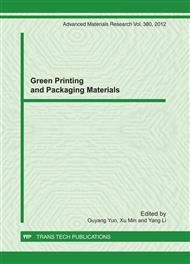p.112
p.117
p.121
p.125
p.129
p.133
p.137
p.143
p.148
Preparation of Silver Nanoplates and Application in PCB Ink-Jet
Abstract:
Compared with traditional etch processing, inkjet technology has the features of simpler workmanship, less resources-utilizing, lower cost and environmentally friendly adaptation, which is sure to be another innovation of printed circuit board(PCB) technology. In this paper, size and shape controlled silver nanoparticles have been synthesized,which was used as conductive medium in ink-jet inks. Then it was printed into conductive lines on epoxy resin by a drop-on-demand inkjet printer. PVP was used as a polymeric stabilizer providing both electrostatic and steric stabilization. Ag2C2O4 was used to prepared spherical nano-silver. In the preparation of flake-like silver powders, the fully inorganic phase system contains AgNO3 as a silver precursor, DMF as a as a media dissolving silver salt, and PVP as a reducing reagent. The morphologies and structures of the nanoparticles were characterized by X-ray diffraction (XRD) and transmission electron microscopy (TEM). It was shown that the sample is silver with cubic asymmetry from the pattern of XRD. TEM images indicated that the size of spherical nano-particles was no more than 20 nm. But the small triangular nanoplates, with rather narrow size distribution, were in the range from 20nm up to 60 nm in edge length. The electrical conductivity was also measured by the four-probe tested method after calcined on the substrates. It was shown that the conductivity was 25S/cm when adding the spherical powders and the nano-silver ink has been successfully designed for inkjet printing.
Info:
Periodical:
Pages:
129-132
Citation:
Online since:
November 2011
Authors:
Keywords:
Price:
Сopyright:
© 2012 Trans Tech Publications Ltd. All Rights Reserved
Share:
Citation:


